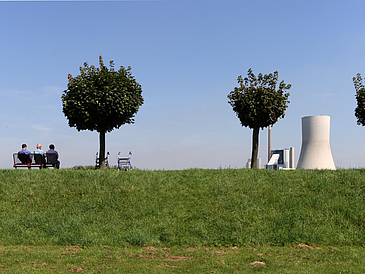A new measuring campaign conducted by researchers has shown how a new technology is capable of tracking down emission sources of greenhouse gases from very high altitudes. The European Space Agency commissioned the University of Bremen’s Institute of Environmental Physics (IUP) to oversee the measurements. For the first time, measurements taken from aircraft using specially designed sensors have shown it is possible to precisely trace the sources of local emissions of the most important greenhouse gases CO2 and methane (CH4) from the sky. In future such measurements may well be carried out from space. The findings represent a major milestone on the way to developing a satellite supported sensing system (“CarbonSat”) that will in future be able to make independent measurements of greenhouse gases worldwide.
The measurements were carried out using specially equipped aircraft during the summer of 2012. The issue at stake: Can changes of amounts of CO2 in the atmosphere, caused by emissions from coal-fired power plants for example, be measured so precisely that it is possible to reliably trace where the emissions come from? We already know about the emissions given off coal-fired power stations in Germany. This is not the case for sources of emissions in many other countries, though. An important objective pursued by the CarbonSat project is now to apply the tested technology in search of so far unknown sources. CarbonSat is also able to ascertain how much carbon dioxide in the atmosphere is absorbed by plant life. In combination, the measurements will help researchers determine how natural processes and human-made emissions influence the climate and vice versa.
During the course of the measurement campaign, sensor technology developed in Bremen called MAMAP took measurements of the CO2 “cloud” emitted by a coal-fired power plant from an extremely high altitude, i.e. under similar conditions as from a satellite. Measurements of cross sections of the CO2 “cloud” were also made. The latter were carried out using a high-precision standard procedure, enabling robust testing of the results obtained by the new MAMAP technology. In addition to the CO2 emissions, the researchers also measured the methane emissions rising from ventilation shafts in an active coal mine.
Evaluation of the data obtained using MAMAP found:
- Spectroscopic remote sensing techniques are capable of precisely measuring even slight changes in concentrations of CO2 and CH4
- Independent control measurements carried out by an accompanying aircraft using a standard technology confirmed the accuracy of the new remote sensing method.
Following this success, this year the IUP researchers will cooperate with an American team on a second round of experiments in California. Beside the favorable weather conditions there, California also has a number of interesting “hot spots” to offer (for example leakages of natural gas on the seabed). This project will be supported by ESA together with NASA. The Bremen environmental scientist and initiator of the MAMAP project, Heinrich Bovensmann, takes an optimistic view of the future: “In the meantime, we have made so much progress that we are now able to drastically improve on the measuring technique employed in the aircraft. The project titled ‘MAMAP Next Generation’ is now ready to go."
You can obtain further information by contacting:
University of Bremen
Institute for Environmental Physics
Heinrich Bovensmann
Phone: +49 421 218 62102
email: heinrich.bovensmannprotect me ?!uni-bremenprotect me ?!.de
CarbonSat Universität Bremen: www.iup.uni-bremen.de/carbonsat
For more background information (German): www.iup.uni-bremen.de/deu/downloads/CarbonSat_PM_Uni-Bremen_Langversion_mit_Bildmaterial_DE_v4.pdf
ESA Web story on CarbonSat (English):www.esa.int/Our_Activities/Observing_the_Earth/The_Living_Planet_Programme/Campaigns/Pinpointing_sources_of_greenhouse_gases
METAIR:www.metair.ch/
ESA Earth Explorers:www.esa.int/Our_Activities/Observing_the_Earth/The_Living_Planet_Programme/Earth_Explorers

